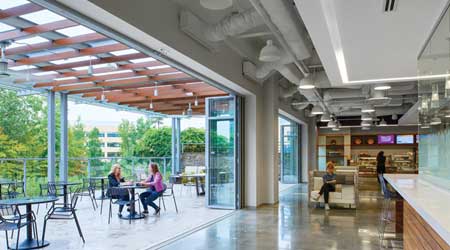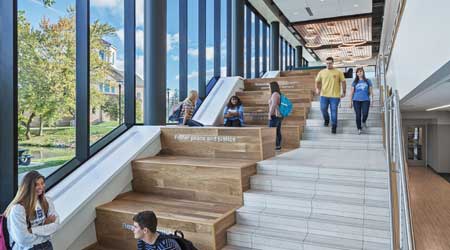 Flexible indoor/outdoor spaces offer fresh air and sunshine that boost morale and encourage remote employees to visit more frequently.Ryan Kurtz Photography
Flexible indoor/outdoor spaces offer fresh air and sunshine that boost morale and encourage remote employees to visit more frequently.Ryan Kurtz PhotographyShift to Health and Wellness Brings Post-Pandemic Advantages
Workplaces that prioritize health and wellness, certifying with WELL or Fitwel, will be more valuable and will be better able to recruit and retain top talent.
Pre-pandemic, occupants wouldn’t think twice about piling into an elevator to take them up just a few floors to their destination. That probably won’t be the case anymore, and so depending on the size of a building, facility managers need to figure out how — with wayfinding, signage, and designating certain stairwells entrance and others egress (if possible)— to make it easier for occupants to take the stairs, while being able to maintain social distancing, as well. That’ll both help prevent infection spread in a crowded, cramped elevator, and also simply give employees a quick burst of exercise.
Indeed, many strategies facilities managers should consider will have benefits both for active and preventive health. One thing we learned pretty quickly during the pandemic was that while healthy people were just as likely to contract COVID-19, they often handled the illness much better and recovered quicker than people who had underlying health conditions. For that reason, many people have made getting healthy a priority, and they’ll be looking to the workplace to help them further that goal.

(Open and inviting stairways encourage people to increase step counts and skip the elevator. Credit: Cory Klein Photography)
This also means workplaces that prioritize health and wellness strategies in the post-pandemic world will be more attractive to top talent than in the past. “The creation of a safe environment for employees leads to higher retention, higher retention leads to better workflow efficiency, and efficiency leads to profit,” says Katie McHugh, design director for NELSON Worldwide. “We have also learned that people who feel healthy and safe are more productive and balanced in their work.”
But in the post-pandemic world, conversations will move well beyond what it means to keep occupants safe and include these conversations about active health and wellness, as well. “Safety has often dominated the conversation, as people need to feel secure in buildings to want to spend time in them,” says Garrett Ferguson, sustainable building advisor for Perkins and Will. “Health is just as critical, and we’ve seen growing studies and conversations regarding ‘healthy buildings’ ever since the rise of ‘sick building syndrome.’ I think that recent events will elevate those conversations, and also bring health and wellness to the forefront of company priorities.”
LEED certified buildings have been shown to command a premium for rent and a better ability to recruit and retain top talent, and many experts see that being the case for health and wellness-focused rating systems like WELL and Fitwel, as well. These rating systems add a bit of initial cost and a lot of complexity to any project, but even before the pandemic, experts touted the financial payback of using these rating systems in terms of improved productivity. With a premium of $4 to $5 per square foot, which might be on the high end, “you can get a 20 percent productivity gain for people who (have certified) space,” says Carney. “That’s a pretty minor investment, for a pretty major gain.”
Like LEED certified buildings, WELL and Fitwel certified buildings also will be more valuable. “There is clear evidence that buildings that make health and wellness a centerpiece are simply worth more,” says Scialla. “Health and wellness is not just an investment in people. By definition, it’s an investment in the asset itself.”
In many cases, it’ll be up to the facility manager to keep occupants and top management apprised of these initiatives to ensure buy-in and to relate their effectiveness — financial and otherwise. “The communication of these new health and wellness guidelines and protocols is crucial,” says Brigitte Preston, principal and interior design director for the Dallas office of Perkins and Will. “Change management is key to create new habits and to support employees in this new normal.”
Related Topics:















